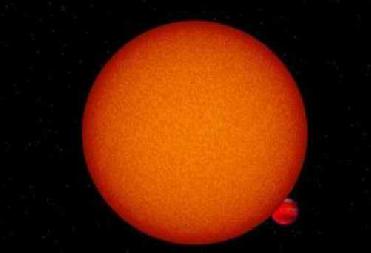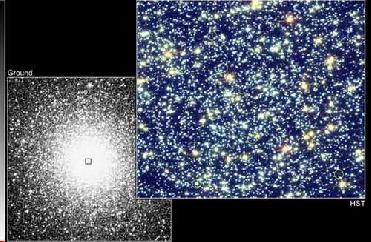
This artist's impression shows the star OGLE-TR-56 and its planet, as it passes behind the star. Credit: © D. Sing (IAP) / A&A
WASHINGTON, DC (BNS): Two independent groups have simultaneously made the first-ever ground-based detection of extrasolar planets thermal emissions.
Until now, virtually everything known about atmospheres of planets orbiting other stars in the Milky Way has come from space-based observations. These new results, accepted for publication in Astronomy & Astrophysics, open a new frontier to studying these alien worlds and are especially critical because the major space-based workhorse to these studies, the Spitzer telescope, will soon run out of cryogens, highly limiting its capabilities.
One team of scientists observed a planet named OGLE-TR-56b, which is a "hot Jupiter." Hot Jupiters are massive planets that orbit very close to their stars, whipping around them in 2 to 3 days. Since they are so close to their stars, they are believed to be hot enough to emit radiation in the optical and near-infrared wavelengths and be detectable from Earth.
The orbit of OGLE-TR-56b carries it behind its host star from the perspective of an observer on Earth, but a challenge to observing is that the planet is faint and in a crowded field, located in the direction of the center of our galaxy, about 5,000 light years away.
"Others have tried to detect planetary atmospheres from Earth, but to no avail," remarked co-author Mercedes L�pez-Morales at the Carnegie Institution's Department of Terrestrial Magnetism.
"We hit it right two nights last summer. The successful recipe is a planet that emits a lot of heat and has little to no wind in its atmosphere. Plus it has to be a clear, calm night on Earth to measure accurately the differences in thermal emissions when the planet is eclipsed as it goes behind the star. Only about one of every 3,000 photons from the star comes from the planet. This eclipse allows us to separate the emissions of the planet from those of the star. The magic moments came on July 2nd at the European Southern Observatory's Very Large Telescope (VLT) and on August 3rd on Carnegie's Magellan-Baade telescope in Chile, L�pez-Morales said.
Along with colleague Sara Seager, Lopez- Morales had earlier predicted that the ideal candidate for such a detection would be a planet with the characteristics of OGLE-TR-56b.
The scientists obtained over 600 images from both telescopes. "Because that part of the galaxy is so crowded and the planet so faint we needed these large telescopes," explained lead author David Sing from Institut d'Astrophysique de Paris. "The planet is glowing red-hot like a kitchen stove burner, but we had to know precisely when the eclipse was going to happen and measure the stellar flux very accurately so it could be removed to reveal the planet's thermal emission."
In the other study, published in the same issue of the journal, astronomers in the Netherlands detected thermal emission in the near infrared from another exoplanet named TrES-3b, also from the ground. Information about atmospheres of hot Jupiters from Spitzer studies has helped both sets of scientists. The hot Jupiters Spitzer has observed have similar atmospheric properties, in particular thermal inversions, in which a warm layer holds a cooler layer underneath.
"OGLE-TR-56b is hotter than any that Spitzer has seen so far," said L�pez-Morales. "At over 4400� F it's the hottest atmosphere yet measured. It is way too hot for silicon or iron clouds to form, which would keep it dark�typical of the hot Jupiters that Spitzer had found. It's comforting to know that when Spitzer goes out of service, studies like these two will be able to keep the field alive."
 Previous Article
Previous Article Next Article
Next Article













The Indian Air Force, in its flight trials evaluation report submitted before the Defence Ministry l..
view articleAn insight into the Medium Multi-Role Combat Aircraft competition...
view articleSky enthusiasts can now spot the International Space Station (ISS) commanded by Indian-American astr..
view article